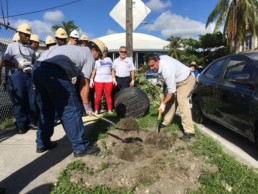SHADE Project Expansion
SHADE Project Expansion
Year Complete: 2018
Grant Amount: $50,000
Local Government: Miami-Dade County Office of Sustainability, Miami-Dade County Parks, Recreation, and Open Spaces Department
Local Foundation: Health Foundation of South Florida
Project Purpose
To expand upon the success of the SHADE project to improve the public transit experience by creating cool, sustainable bus stops and corridors by planting trees.
Key Lessons Learned
Lessons learned about tools and tactics through the project that other sustainability directors could use to advance their work.
- The tree tags created a system of accountability with our tree vendors and streamlined our inventory of trees through the online GIS tool the tags generated. These tools and the location selection model were scaled and replicated in a quick fashion to build upon not only the work of sustainability director but also the common goal among community groups to provide tree canopy throughout the County.
- Local place-based foundations and their natural grassroots approach and understanding of their communities truly enhanced the allocation of resources for the local government sustainability director. A collaborative process in which the foundations identified ideal tree planting locations along with appropriate tree species allowed the local government to properly direct assets. This not only sped up the sustainability director initiatives, but also simultaneously addressed community issues.
- The Photovoice mass media campaign was successful in obtaining impressions and comments, but did not gather additional green bus stop ideas for tree planting locations. The concept of utilizing social media platforms for this type of engagement was aligned with best practices, but did not obtain the intended results for this project.
Lessons for developing a collaborative process between a local government sustainability director and local place-based foundation(s).
- Strong project coordination is essential. With a number of partners on the project, it was important to have roles and responsibilities clearly defined, with a coordinator that could manage tasks and the calendar. It was also important to have a back-up plan in the case of staff turnover or leave of absence.
- Identifying locations for tree plantings was challenging, especially in an urban environment. In Little Havana, many of the locations initially identified as potential tree-planting sites were paved over. There were some funds set aside to have the city remove concrete and asphalt in these areas, but the project team found that the process to get approval would have drastically slowed down the project and prevented planting during the rainy season.
- Results from tree plantings were not immediate. Although there was an immediate visual difference to the stops and corridors where the trees were planted, it takes time for the trees to grow to the point where they are providing enough shade to cool the area.
Additional Information and Resources
This was the second phase of a project that began as an effort to plant trees in Miami Gardens and Little Havana to incentivize residents to engage in physical recreation and/or exercise. Its success paved the way for improving access to transit stops, and increasing the number of accommodations in the transit areas. Read more about each phase of this project here.

